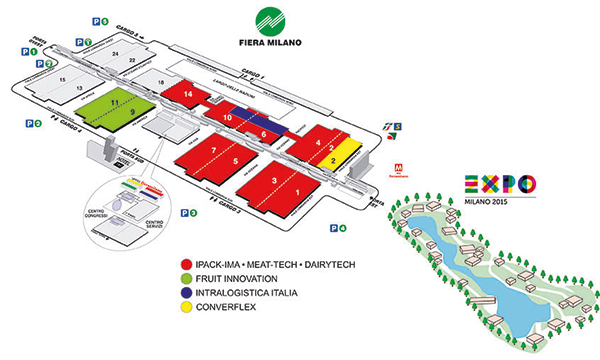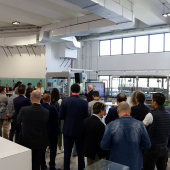Awaiting Ipack-Ima
The intense international promotion fielded by the organizers of Ipack-Ima 2015 is offset by the stages of technological insight, that are featuring in the months leading up to the big engagement scheduled 19 to 23 May in FieraMilano. Focus on the processing of cheese and dairy products and on systems for preparing, filling and distributing food liquids and other liquid forms.

Processing whey: from cost to added value
Basically, with milk you don’t throw away anything. As a matter of fact, few people know that milk is not only an irreplaceable food. The whey derived from cheese production in fact, far from being a waste to be disposed of, is a valuable resource with multiple uses: It can be used to obtain biogas for producing energy, to render asbestos fibers inert, to produce anti-age drinks that strengthen the immune system, to improve the yields of Italian DOP cheeses... Possible uses of whey were the focus of the conference “The new frontiers of processing whey: from cost to added value”, which was held at the Palazzo delle Stelline in Milan on 2 December 2014. Coordinated by Claudio Peri, professor emeritus of the University of Milan and sponsored by Fedagri, the seminar was organized by Dairy Tech, the fair dedicated to processing and packaging technologies for the dairy sector, which will be held simultaneously with Ipack-Ima 2015.
Good practices by the industry During the encounter some exemplary case studies of innovative companies were presented that have been able to create added value from this derivate.
For example, Chemical Center of Castello d’Argile (BO) has patented a system that, using cheese whey, enables the removal of the cement part of the slabs of Eternit to then destroy the asbestos fibers with a heat treatment at 180° C . Or again, the cheesemaker Moro of Motta di Livenza (TV) in turn covers approximately 75% of its energy needs via the fermentation of milk processing waste, extracting methane and ethanol to generate the heat and electricity needed to produce and refrigerate their cheese.
Whey also fosters a thriving world trade: 6 billion euros in 2013, up 30% on 2011, and this is even more good news for Italy because the country produces a lot of whey: 8 million tons per year.
Liquid Handling & Filling
The liquid preparation, filling and distribution technologies (food and otherwise) were the subject of the conference “Liquid Handling & Filling” organized as part of the Ipack-Ima Days, promoted by Ipack-Ima in collaboration with AIDIC (Italian Association of Chemical Engineering) and with the sponsorship of the DEFENS Department of the University of Milan. The packaging of liquid products raises some critical issues that concern both packaging materials (from flexible to rigid, from multilayer structures to mono-materials, from virgin to recycled material) and filling techniques, which have to adapt to the chemical and physical properties of each liquid, that vary a lot from case to case.
The technologies are hence specifically linked to the various sectors, a situation that was gone into during the seminar.
From cosmetics to food
A first set of talks dealt with themes related to liquid filling hygiene in the cosmetics and detergency sectors.
Compact filling and capping systems were presented, such as the line for syrups proposed by Omas Tecnosistemi, which also incorporates a bottle cleansing station. One then moved on to examine the petroleum sector, with its peculiar problems, related to the treatment of complex viscous products. In this context, the physical properties of the fluids are likely to slow down the filling of storage tanks, with repercussions on time and cost of production: an answer comes from ENI SpA, which has optimized the process of mixing and filling.
The food sector was also subject to reflection: innovations in this area focus on the design of systems that are as integrated as possible. An example in this direction is the Krones ErgoBloc system, which integrates the functions of blow molding, labeling, filling and capping, with different types of filling (normal, aseptic, not aseptic, ultraclean). In this sector the focus on laws that protect the health of consumers in terms of hygiene and preservation is paramount.
Consquentlly, legislation for recycled polymers used in food packaging and in particular PET was examined, summarizing the precautions to be taken to ensure the safety of packaging made out of R-PET. A look was subsequently taken at precautions needed in bottling water, also in large formats.
Lastly, the bottling of vinegar and oil was examined.
For the former, the use of plastic packaging has only recently been made possible with the introduction of some European standards that exceeded the limitations imposed by national ones. A series of case studies have instead supported the advancement of research related to the design, prototyping and industrial production of innovative polyester packaging for edible oils, active, flexible PET packaging and a study of environmentally friendly bottles made using up to 100% R-PET.



















